Barbarosa
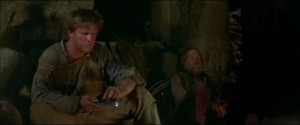 There’s a very valid reason for Mel Brooks not being particularly visible to the press during the production of two classics of the 1980s. His production company, Brooksfilms, was responsible for both David Lynch’s The Elephant Man and David Cronenberg’s The Fly, but Brooks went uncredited as an executive producer. If you knew that Brooks was involved before sitting down to watch these incredibly serious and depressing films, what are the chances you would take the film seriously? Once your mind focuses on the notion of parody, it’s unlikely that you’ll be able to snap out of it and give the movie a fair chance.
There’s a very valid reason for Mel Brooks not being particularly visible to the press during the production of two classics of the 1980s. His production company, Brooksfilms, was responsible for both David Lynch’s The Elephant Man and David Cronenberg’s The Fly, but Brooks went uncredited as an executive producer. If you knew that Brooks was involved before sitting down to watch these incredibly serious and depressing films, what are the chances you would take the film seriously? Once your mind focuses on the notion of parody, it’s unlikely that you’ll be able to snap out of it and give the movie a fair chance.
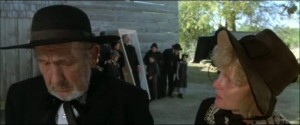 It’s certainly strange when you see a “directed by” credit for Jerry Zucker on a film like Ghost or First Knight, when he, along with his brother David and Jim Abrahams wrote and directed Airplane, The Naked Gun, and Top Secret. It doesn’t help that both Ghost and First Knight play their material straight, no matter how fantastical they get, practically inviting you to mock them.
It’s certainly strange when you see a “directed by” credit for Jerry Zucker on a film like Ghost or First Knight, when he, along with his brother David and Jim Abrahams wrote and directed Airplane, The Naked Gun, and Top Secret. It doesn’t help that both Ghost and First Knight play their material straight, no matter how fantastical they get, practically inviting you to mock them.
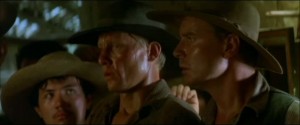 It’s the same reaction you might have when you’d see Lord Lew Grade’s name (sometimes credited as Sir Lew Grade) and/or his ITC Pictures in the opening credits. Often referred to as Sir Low Grade, Lew was responsible for putting Gerry Anderson’s marionette based world on British TV, such as the perpetually schlocky Thunderbirds and Stingray. Grade moved on to getting The Muppets on TV and eventually in the movies (where Grade was played/approximated by Orson Welles), but he wasn’t about be taken seriously by the press. When, in 1980, Grade interfered with the dopey and pricey Kirk Douglas/Farrah Fawcett sci-fi film Saturn 3 and fostered his own disaster with Raise the Titanic, his fate was sealed. It hardly mattered what was already in production by that point, the end was near.
It’s the same reaction you might have when you’d see Lord Lew Grade’s name (sometimes credited as Sir Lew Grade) and/or his ITC Pictures in the opening credits. Often referred to as Sir Low Grade, Lew was responsible for putting Gerry Anderson’s marionette based world on British TV, such as the perpetually schlocky Thunderbirds and Stingray. Grade moved on to getting The Muppets on TV and eventually in the movies (where Grade was played/approximated by Orson Welles), but he wasn’t about be taken seriously by the press. When, in 1980, Grade interfered with the dopey and pricey Kirk Douglas/Farrah Fawcett sci-fi film Saturn 3 and fostered his own disaster with Raise the Titanic, his fate was sealed. It hardly mattered what was already in production by that point, the end was near.
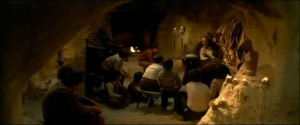 Fred Schepisi’s Barbarosa was caught right in the middle of that mess, and while the association with Grade’s name didn’t hurt the film, that’s only because ITC shut down its distribution arm and Barbarosa was pulled from theaters after two weeks. The cluttered back-story of Barbarosa production is a shame, not just because a great Western was hidden from public view for 30 years (unless you count the poorly cropped video and DVD releases), but because Barbarosa is such a small, sneaky film. Events seem unsubstantial in and of themselves, but the larger picture, harping on one of Schepisi’s ongoing themes, is about myth-making and the importance of societal perception over reality [Which he also explored in The Priest, Six Degrees of Separation, Roxanne, A Cry in the Dark, etc.] The fact that the diminutive Willie Nelson plays the titular character, a towering, feared thief and gunman is part of the point, as is the fact that his partner played by Gary Busey (who was nearly 40 at the time) is known as a “child,” as he towers over Nelson and the other characters (who are almost all Mexican).
Fred Schepisi’s Barbarosa was caught right in the middle of that mess, and while the association with Grade’s name didn’t hurt the film, that’s only because ITC shut down its distribution arm and Barbarosa was pulled from theaters after two weeks. The cluttered back-story of Barbarosa production is a shame, not just because a great Western was hidden from public view for 30 years (unless you count the poorly cropped video and DVD releases), but because Barbarosa is such a small, sneaky film. Events seem unsubstantial in and of themselves, but the larger picture, harping on one of Schepisi’s ongoing themes, is about myth-making and the importance of societal perception over reality [Which he also explored in The Priest, Six Degrees of Separation, Roxanne, A Cry in the Dark, etc.] The fact that the diminutive Willie Nelson plays the titular character, a towering, feared thief and gunman is part of the point, as is the fact that his partner played by Gary Busey (who was nearly 40 at the time) is known as a “child,” as he towers over Nelson and the other characters (who are almost all Mexican).
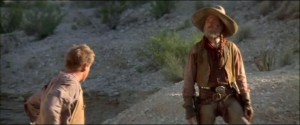 These quirks help Barbarosa some of the more confusing elements (a lot of the backstory is sort of mumbled over, the passage of time is perpetually unclear) and contrivances (so why does Nelson, trying to keep up outlaw appearances, team up with yokel farmboy Busey in the first scene?), as well as the occasional hokey music which goes from Casio to didgeridoo without pausing to breathe. Then the orchestral score kicks in, which sounds like The Boston Pops trying to play gritty western music. The music especially seems like one of Grade’s tone-deaf intrusions on the film, at odds with the realistic sloppiness and moral gray areas that Schepisi presents us with. There are no crack shots in Barbarosa, people are killed because they’re more exhausted than their enemy, very much like the way the terrific sword fights in Rob Roy were handled.
These quirks help Barbarosa some of the more confusing elements (a lot of the backstory is sort of mumbled over, the passage of time is perpetually unclear) and contrivances (so why does Nelson, trying to keep up outlaw appearances, team up with yokel farmboy Busey in the first scene?), as well as the occasional hokey music which goes from Casio to didgeridoo without pausing to breathe. Then the orchestral score kicks in, which sounds like The Boston Pops trying to play gritty western music. The music especially seems like one of Grade’s tone-deaf intrusions on the film, at odds with the realistic sloppiness and moral gray areas that Schepisi presents us with. There are no crack shots in Barbarosa, people are killed because they’re more exhausted than their enemy, very much like the way the terrific sword fights in Rob Roy were handled.
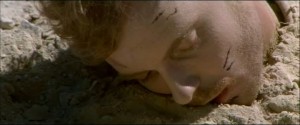 The clumsy fights aid Schepisi in avoiding spoon feeding everything to us, without belying the unsophisticated core of the time period. “I thought you wanted to rob and pillage,” an angry Nelson says to a squeamish Busey after he refuses to steal from some poor villagers. It’s a funny line, but also exemplifies the simplicity with which the film’s rivalries develop, there’s simply not a lot to concern yourself with, and anger and revenge become a valid way of passing the time. That’s where one of Schepisi choices, something he implements in a lot of his films, rears its head. Schepisi has a way of giving the audience imagery that obscures emotional pain while showing us physical pain and vice versa, so we never associate the two, as if there was no correlation. A close-up of a nasty, fresh wound above the bosom of a prostitute could reveal her internal pain, but we don’t see her face in the same shot. Nelson’s revenge-minded father-in-law has only one leg, but you rarely, if ever see him in a medium shot where both his disability and his scowling face are simultaneously in focus.
The clumsy fights aid Schepisi in avoiding spoon feeding everything to us, without belying the unsophisticated core of the time period. “I thought you wanted to rob and pillage,” an angry Nelson says to a squeamish Busey after he refuses to steal from some poor villagers. It’s a funny line, but also exemplifies the simplicity with which the film’s rivalries develop, there’s simply not a lot to concern yourself with, and anger and revenge become a valid way of passing the time. That’s where one of Schepisi choices, something he implements in a lot of his films, rears its head. Schepisi has a way of giving the audience imagery that obscures emotional pain while showing us physical pain and vice versa, so we never associate the two, as if there was no correlation. A close-up of a nasty, fresh wound above the bosom of a prostitute could reveal her internal pain, but we don’t see her face in the same shot. Nelson’s revenge-minded father-in-law has only one leg, but you rarely, if ever see him in a medium shot where both his disability and his scowling face are simultaneously in focus.
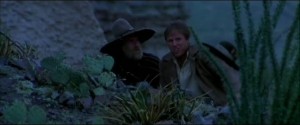 Schepisi doesn’t take the easy way out in Barbarosa’s brief running time, so despite the opportunity for some beautiful widescreen vistas, he doesn’t use them as a crutch or a cheap conduit for a scene transition without a proper segue. [Well, other than Busey’s unbelievably toothy grin.] There are visual references to The Searchers, tracking shots through arches that open up into the vastness of the world, but Schepisi isn’t making a pictorial. He’s after a balance between the intentionally and incidentally comic (Busey goes Amish!), so the irony of Nelson robbing people so he can support his family, most of whom want to kill him doesn’t seem like idiocy, rather a casualty of situation. When we see one of Nelson’s adversaries buried up to his neck in sand (as was true in The Challenge, something must have been in the sand in 1982) encircled by two already dead bodies buried next to him, the fact no one ever thinks to dig him out, they just let him die, is like a pre-Darwinist way of thinking. Barbarosa’s foes, who are also thieves, are just like him, and that’s why they hate him.
Schepisi doesn’t take the easy way out in Barbarosa’s brief running time, so despite the opportunity for some beautiful widescreen vistas, he doesn’t use them as a crutch or a cheap conduit for a scene transition without a proper segue. [Well, other than Busey’s unbelievably toothy grin.] There are visual references to The Searchers, tracking shots through arches that open up into the vastness of the world, but Schepisi isn’t making a pictorial. He’s after a balance between the intentionally and incidentally comic (Busey goes Amish!), so the irony of Nelson robbing people so he can support his family, most of whom want to kill him doesn’t seem like idiocy, rather a casualty of situation. When we see one of Nelson’s adversaries buried up to his neck in sand (as was true in The Challenge, something must have been in the sand in 1982) encircled by two already dead bodies buried next to him, the fact no one ever thinks to dig him out, they just let him die, is like a pre-Darwinist way of thinking. Barbarosa’s foes, who are also thieves, are just like him, and that’s why they hate him.




Danny De La Paz says:
December 3rd, 2012
8:22 pm
I am one of the co-stars of this film and I enjoyed reading your insightful review. I am looking for an UNCUT WIDESCREEN version of this film on dvd if such a thing exists. A key scene toward the end of the movie was cut before it’s release which would have explained the reason for the perpetuation of the Barbarosa myth. If you know where to get a letterboxed uncut version (director’s cut) please let me know at atomboy13@gmail.com. Thanks…Danny De La Paz “Eduardo”.